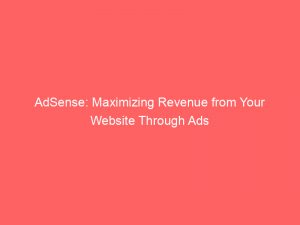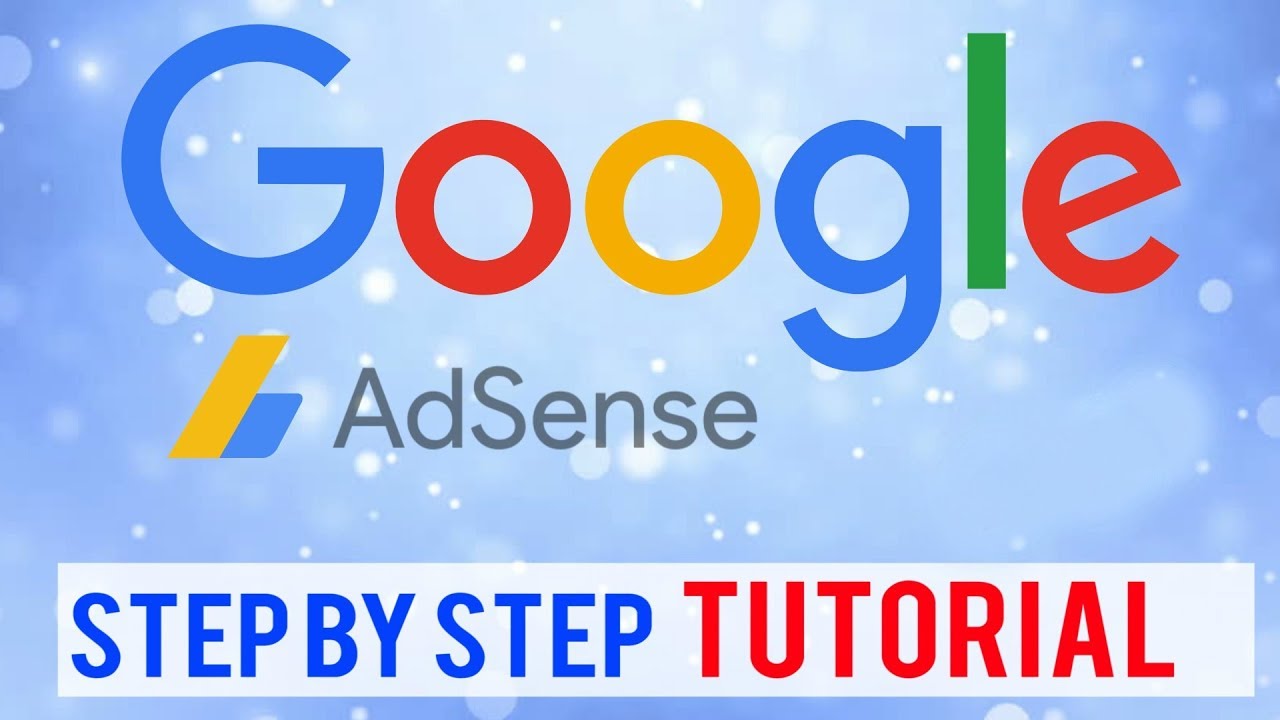- ad sense
- How Adsense Works: Matching Ads To Content
- Earning Potential: Varying Prices For Ads
- Three Steps Of Adsense: Availability, Displaying, And Payment
- Real-Time Auction: Advertisers Compete For Ad Spaces
- Google’s Role: Billing Process For Ads
- Free To Use: Publishers Earn For Clicks, Impressions, And Interactions
- Ad Auction: Determining Ads On A Site
- Publisher Guidelines: Viewing Ads But Avoiding Clicks
In today’s digital age, monetizing online content has become a top priority for publishers worldwide. Enter GoogleAdSense, an innovative platform that revolutionizes the way publishers earn money.
By leveraging sophisticated algorithms and cutting-edge technology, AdSense seamlessly matches ads to online content and visitors, creating a win-win situation for both publishers and advertisers. The thrill lies in the auction-like system where advertisers bid for prime ad spaces, ensuring the highest revenue potential for publishers.
With AdSense, publishers gain access to a vast network of advertisers, ensuring that every ad displayed is relevant and engaging. Prepare to delve into the fascinating world of AdSense, where possibilities abound and revenue flows effortlessly.
| Item | Details |
|---|---|
| Topic | AdSense: Maximizing Revenue from Your Website Through Ads |
| Category | Ads |
| Key takeaway | In today's digital age, monetizing online content has become a top priority for publishers worldwide. |
| Last updated | December 27, 2025 |
ad sense
AdSense is a program by Google that allows publishers to monetize their online content. It works by matching ads to a publisher’s site based on its content and visitors.
Publishers can earn money from their content as advertisers pay different prices for different ads. The process involves three steps: making ad spaces available, displaying the highest paying ads through a real-time auction, and ultimately paying the publishers.
Google handles the billing process for ads on the site, freeing publishers from this responsibility. AdSense is free to use, and publishers get paid for clicks, impressions, and interactions.
It provides access to a large source of advertiser demand, ensuring more relevant ads for publishers’ sites. It’s important for publishers to remember not to click on their own ads, as an ad auction determines which ads appear on their site.
Key Points:
- AdSense is a Google program that allows publishers to monetize their online content by matching ads to their site based on content and visitors.
- Publishers can earn money from different ads as advertisers pay different prices for them.
- The process involves making ad spaces available, displaying the highest paying ads through an auction, and ultimately paying the publishers.
- Google handles the billing process, freeing publishers from this responsibility.
- AdSense is free to use and publishers get paid for clicks, impressions, and interactions.
- It provides access to a large source of advertiser demand, ensuring more relevant ads for publishers’ sites.
Sources
https://adsense.google.com/start/
https://support.google.com/adsense/answer/6242051?hl=en
https://support.google.com/adsense/answer/10190?hl=en
https://support.google.com/adsense/answer/1709858?hl=en
Check this out:
? Pro Tips:
1. Optimize your website’s content: To increase the chances of getting higher paying ads, make sure your website’s content is relevant, well-organized, and of high quality. AdSense matches ads to your site based on its content, so the better your content, the more relevant and valuable the ads will be.
2. Experiment with ad placement: Different ad placements can have varying levels of effectiveness in attracting clicks. Test different positions and formats to find the most optimal placements for your ads. Keep track of the performance metrics provided by AdSense to make informed decisions.
3. Monitor and analyze your ad performance: Take advantage of the data and analytics provided by AdSense to gain insights into how your ads are performing. This can help you identify trends, optimize your ad strategy, and make adjustments to increase your revenue.
4. Consider using responsive ad units: Responsive ad units automatically adjust their size and format to fit different screen sizes and devices. By using responsive ads, you can ensure that your ads are displayed optimally across various platforms, increasing the chances of generating clicks and impressions.
5. Focus on improving user experience: A positive user experience not only helps retain visitors but also increases the likelihood of them clicking on your ads. Ensure that your website is fast, easy to navigate, and mobile-friendly. This will not only improve your chances of getting more clicks but also help with your overall website performance and ranking.
How Adsense Works: Matching Ads To Content
Google AdSense is a powerful tool that allows publishers to monetize their online content and generate revenue. The core functionality of AdSense lies in its ability to match ads to a publisher’s site based on the content and visitors.
This ensures that the ads displayed are relevant and appealing to the target audience, thereby increasing the likelihood of engagement and conversions.
When a publisher signs up for AdSense, they make ad spaces on their website available for advertisers to bid on. AdSense uses advanced algorithms to analyze the content of the website and determine the most suitable ads to display.
These ads can come in various formats, such as text, images, or videos, enhancing the overall user experience.
Earning Potential: Varying Prices For Ads
The amount earned through Google AdSense can vary significantly as the prices offered by advertisers for displaying their ads differ based on various factors. Advertisers participate in a real-time auction, where they bid on ad spaces.
The highest bidder gets the opportunity to display their ad on the publisher’s website, ensuring that publishers receive maximum revenue for their valuable ad spaces.
It is important to note that not all ads generate the same payouts. Advertisers may have different budgets and objectives, resulting in varying prices for different ads.
Some ads may be highly competitive, attracting higher bids, while others may have lower demand and generate relatively lower revenue for publishers.
Three Steps Of Adsense: Availability, Displaying, And Payment
The process of AdSense can be divided into three simple steps: making ad spaces available, displaying the highest paying ads, and paying publishers for their participation.
In the first step, publishers make their ad spaces available by integrating AdSense into their websites or mobile apps. Google provides publishers with a code snippet that needs to be inserted into the desired locations on the website.
This code allows Google to identify the available ad spaces and deliver targeted ads.
Once ads spaces are made available, AdSense begins displaying ads based on a real-time auction system. Advertisers bid for ad spaces, and the highest paying ads are selected to be displayed on the publisher’s site.
This ensures that publishers maximize their revenue potential by getting the most lucrative ads in front of their audience.
After the ads are displayed and visitors interact with them, publishers are paid by Google. AdSense calculates earnings based on various metrics, including the number of clicks, impressions, and interactions received by the ads.
This comprehensive approach ensures that publishers are compensated for the value they bring to advertisers through their online content.
Real-Time Auction: Advertisers Compete For Ad Spaces
The real-time auction system is a crucial element of Google AdSense that allows advertisers to compete for ad spaces on publishers’ websites. In this dynamic marketplace, advertisers bid for the opportunity to display their ads, while publishers benefit from the highest-paying ads being showcased on their platform.
The auction is conducted instantaneously, ensuring that ads are selected based on their current value and relevance. Advertisers analyze the content and demographics of the website, as well as the potential return on investment, before placing their bids.
This highly competitive environment results in a win-win situation, where publishers receive optimal revenue, and advertisers reach their target audience effectively.
Google’s Role: Billing Process For Ads
One of the key advantages of using AdSense is that publishers do not have to handle the billing process themselves. Google takes care of the entire payment process for ads displayed on the website.
This eliminates the administrative burden for publishers, allowing them to focus on creating valuable content and engaging with their audience.
Google ensures that advertisers are invoiced for their ad campaigns and collects the revenue from them. The accumulated earnings are then disbursed to the publishers according to the agreed-upon payment schedule.
This streamlined process takes the hassle out of financial transactions, making AdSense an attractive option for publishers seeking simplicity and efficiency.
Free To Use: Publishers Earn For Clicks, Impressions, And Interactions
A significant advantage of AdSense is that it is free to use for publishers. There is no upfront cost or subscription fee associated with AdSense, making it accessible to publishers of all sizes.
By integrating AdSense into their website or mobile app, publishers can start generating revenue from their online content immediately.
Publishers earn money through AdSense through various methods, including clicks, impressions, and interactions with ads. Each interaction is tracked and measured, allowing publishers to earn revenue based on the level of engagement generated by the ads.
This incentivizes publishers to create high-quality and engaging content that encourages visitor interaction, ultimately maximizing their earnings potential.
Ad Auction: Determining Ads On A Site
The ad auction is a critical process that determines which ads appear on a publisher’s website. In this dynamic system, advertisers bid for the available ad spaces, and the highest-paying ads are selected for display.
This ensures that the ads shown are relevant and highly likely to capture the attention of the website’s visitors.
When a visitor arrives at a publisher’s site, AdSense conducts a lightning-fast auction to determine the most suitable ads to display. The auction takes into account factors such as the content of the website, the visitor’s demographics, and the relevance of the ad to the visitor’s interests.
By leveraging advanced algorithms and real-time data, AdSense maximizes the effectiveness of ad placements, resulting in higher engagement and better revenue potential for publishers.
Publisher Guidelines: Viewing Ads But Avoiding Clicks
AdSense provides publishers with access to a large source of advertiser demand, enabling them to display more relevant and engaging ads to their audience. However, it is essential for publishers to adhere to certain guidelines to maintain the integrity of the advertising ecosystem.
While publishers can view the ads displayed on their site, it is crucial to avoid clicking on their own ads. Clicking on ads artificially inflates engagement metrics and violates Google’s policies.
To ensure fair competition and accurate measurements, publishers should refrain from clicking on their own ads and instead focus on creating compelling content that naturally attracts visitor interaction.
In conclusion, Google AdSense is a powerful tool that allows publishers to monetize their online content and enhance their revenue potential. By matching ads to content and visitors, AdSense maximizes relevancy and engagement, resulting in higher overall earnings for publishers.
The real-time auction system, managed billing process, and free-to-use nature of AdSense further contribute to its appeal. However, publishers must follow guidelines to maintain the integrity of the advertising ecosystem and avoid clicking on their own ads.
With AdSense, publishers can unlock the full revenue-generating potential of their websites.











